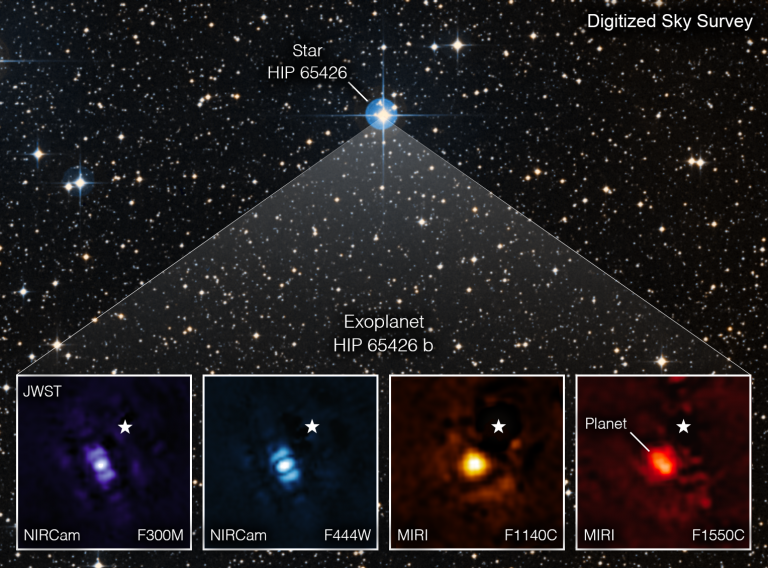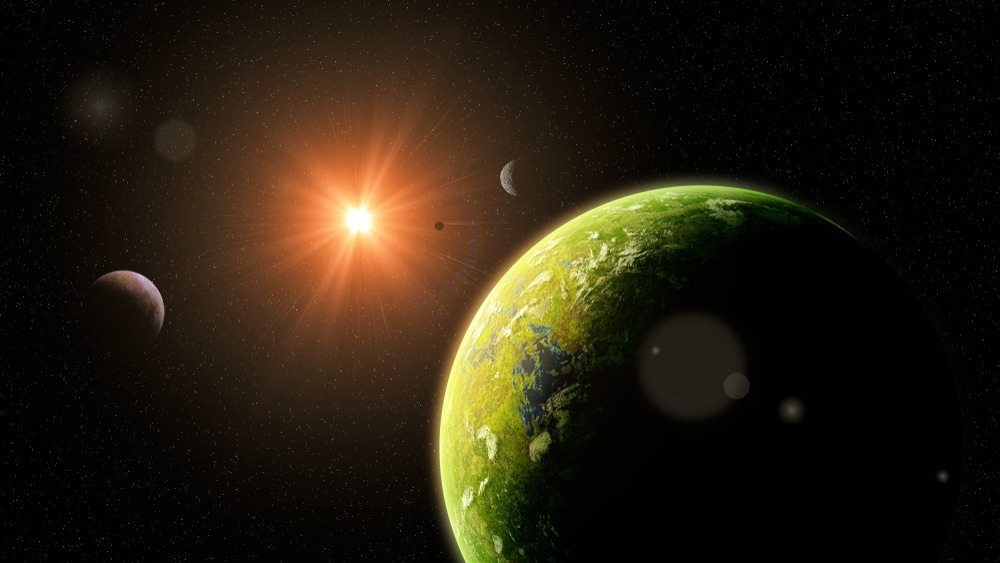Since the discovery of the first planet outside the solar system in 1992, astronomers have mainly relied on indirect methods to observe such worlds.

Images of the exoplanet HIP 65426 b in different wavelengths of infrared light as seen by the James Webb Space Telescope. Image Credit: NASA/ESA/CSA, A Carter (UCSC), the ERS 1386 team, and A. Pagan (STScI).
The James Webb Space Telescope (JWST) has performed its first direct observation of a planet outside the solar system.
The gas giant HIP 65426 b was seen through four different infrared filters, with the observation acting as a demonstration of the JWST’s ability to spot extrasolar planets or exoplanets — planets that orbit stars other than the sun — and gather new information about these worlds.
Such direct observations of exoplanets are rare, with astronomers mainly relying on indirect methods to spot these worlds, and demonstrates the JWST’s value to exoplanet science and learning more about planets beyond the limits of the solar system.
What Do We Know About HIP 65426 b?
Located around 350 light years away from Earth, HIP 65426 b is classified as a ‘super Jupiter’ as it possesses between 6 and 12 times the mass of the solar system’s most massive planet.
Despite being much more massive than Jupiter, HIP 65426 b has a radius just 1.5 times that of the solar system gas giant, meaning that it is denser than Jupiter. Even with this density, as a gas giant HIP 65426 b lacks a solid surface, meaning it is a poor candidate to support life.
The exoplanet is also remarkable because of its age. It is believed to be between 15 to 20 million years old, a cosmic infant in comparison to the 4.5 billion-year-old Earth.
The super Jupiter orbits its star — HIP 65426 — at an average distance of 92 astronomical units. Each astronomical unit is the average distance between Earth and the Sun — 93 million miles — meaning the planet’s average distance from its star is 92 times the distance between our planet and the Sun.
The distance between HIP 65426 b and its star means the planet is much cooler than scorching hot ‘hot Jupiters’ which typically have orbital periods less than an Earth day. HIP 65426 has a leisurely orbit, taking almost 631 Earth-years to orbit its star.
Many of the gas giants spotted using indirect observation methods are so-called ‘hot Jupiters.’ This name arises from the fact that they are near their parent star. This makes the effect they have on that star easier to spot, favoring indirect observation methods.
Expanding the Exoplanet Hunter’s Toolkit
HIP 65426 b is far from the first exoplanet discovered by astronomers, and the JWST cannot even lay claim to being the first telescope to spot the exoplanet. The super Jupiter was discovered in 2017 by the SPHERE instrument on the European Southern Observatory’s Very Large Telescope (VLT) in northern Chile.
That means that the significance of this discovery may not be immediately obvious. What is important about this achievement is the fact that it is a direct observation.
Thus far, astronomers have mainly relied on indirect methods to spot exoplanets. These usually involve finding the effects of the planet on its parent star.

Image Credit: Dotted Yeti/Shutterstock.com
For example, when a planet passes in front of its star — or ‘transits’ its star — as viewed from Earth, it causes a tiny drop in the light output of that star. Known as the transit method, this has been the most successful method of spotting exoplanets, helping the exoplanet catalog grow to contain more than 5,000 worlds.
As light shines through the atmosphere of the exoplanet, astronomers and planetary scientists can also use spectroscopy and the individual ‘fingerprints’ of chemical elements and compounds to access the composition of these atmospheres.
Another highly successful indirect exoplanet observation method involves looking for the tell-tale ‘wobble’ in a star’s motion caused by an orbiting world. This happens because planets don’t technically orbit stars – rather, planets and their stars orbit a point of mutual gravity.
Because stars tend to be much more massive than their planets, this point usually lies deep beneath the star’s surface, meaning that it manifests as a tiny wobble that can be seen by astronomers as a tiny redshift in the light output of the star as it moves away from us slightly, and a blueshift in its light as it moves towards us.
The larger a planet and the closer it is to its star, the larger the ‘wobble’ and thus the more pronounced its red/blue shift. That means this ‘Doppler shift’ technique also favors larger and closer exoplanets.
Considering how impressive a feat this is for the JWST requires remembrance of the fact that the planet is over 10,000 times dimmer than the star it orbits.
HIP 65426 b is also thousands of times fainter than its host star in infrared — the region of the electromagnetic spectrum in which the JWST makes its observations.
Spotting HIP 65426 b required the use of devices attached to the JWST’s Near-Infrared Camera (NIRCam) and Mid-Infrared Instrument (MIRI) called coronagraphs. These tiny ‘masks’ block out starlight and make it possible for the JWST to take direct images of exoplanets.
This means that, unlike those indirect methods, the direct imaging of an exoplanet favors a world like HIP 65426 b, which is some distance from its star.
Sources
NASA’s Webb Takes Its First-Ever Direct Image of Distant World, [2022], [https://blogs.nasa.gov/webb/2022/09/01/nasas-webb-takes-its-first-ever-direct-image-of-distant-world/]
HIP 65426 b, Exoplanet Exploration, NASA, Accessed 09/05/22, [https://exoplanets.nasa.gov/exoplanet-catalog/7220/hip-65426-b/]
Disclaimer: The views expressed here are those of the author expressed in their private capacity and do not necessarily represent the views of AZoM.com Limited T/A AZoNetwork the owner and operator of this website. This disclaimer forms part of the Terms and conditions of use of this website.